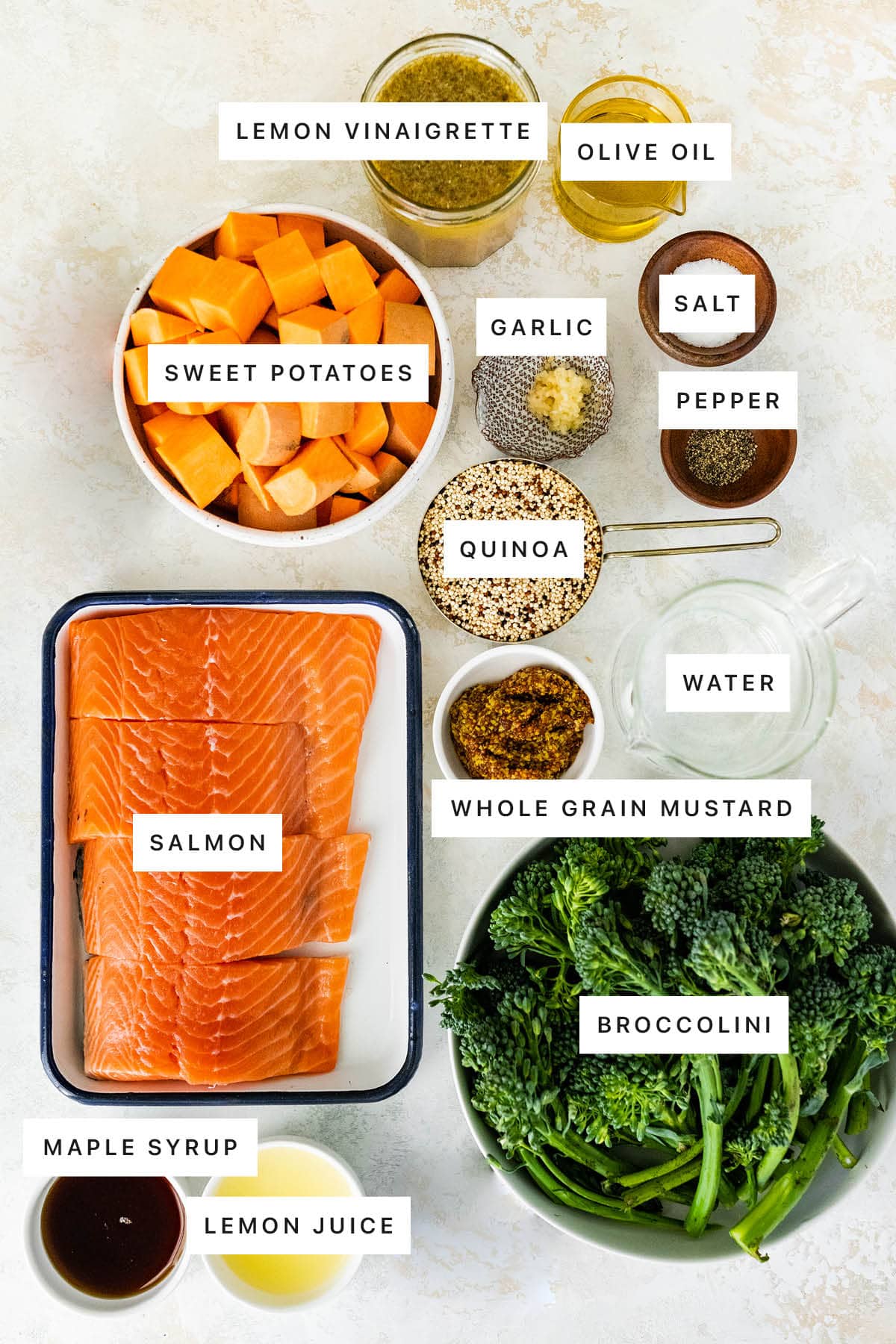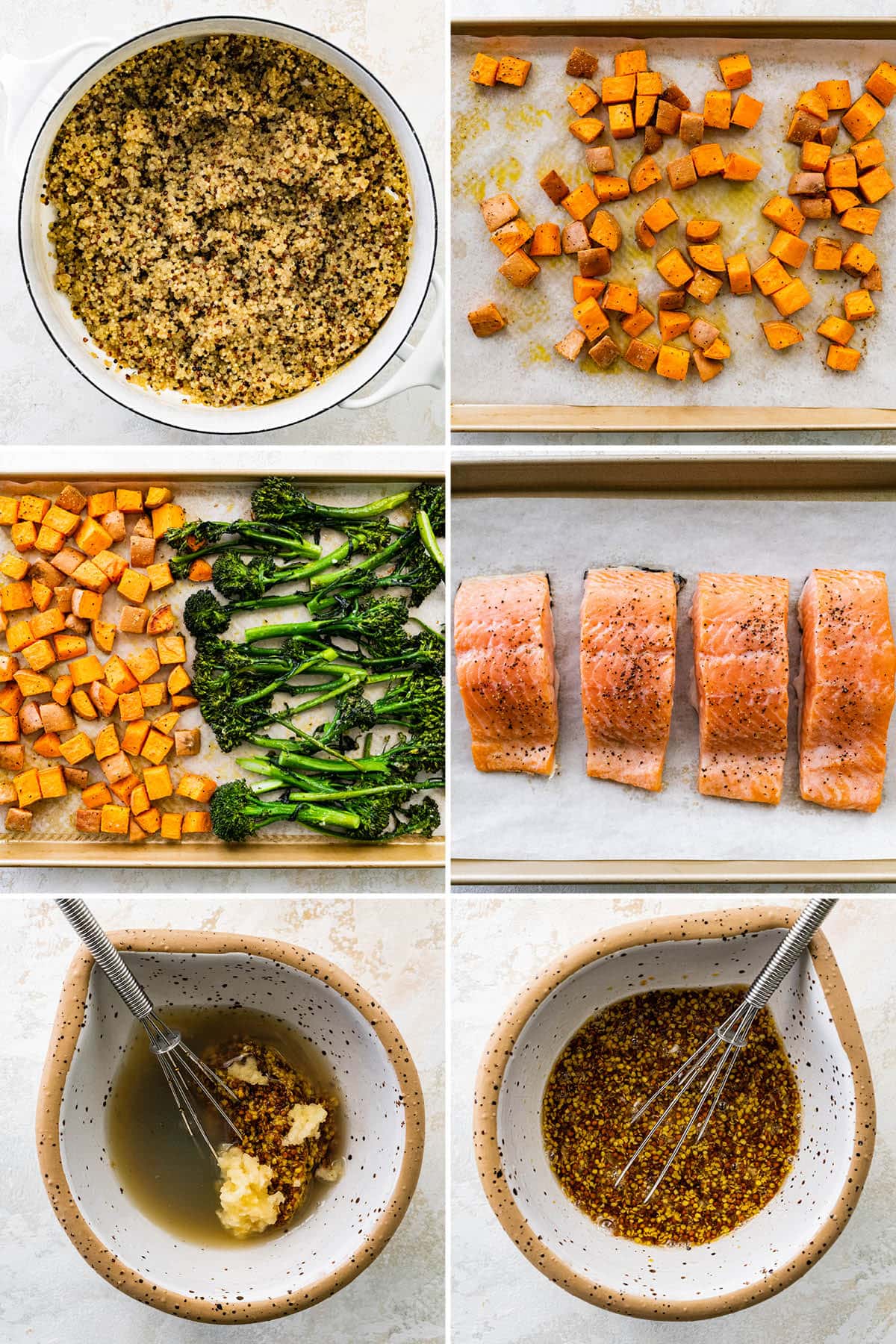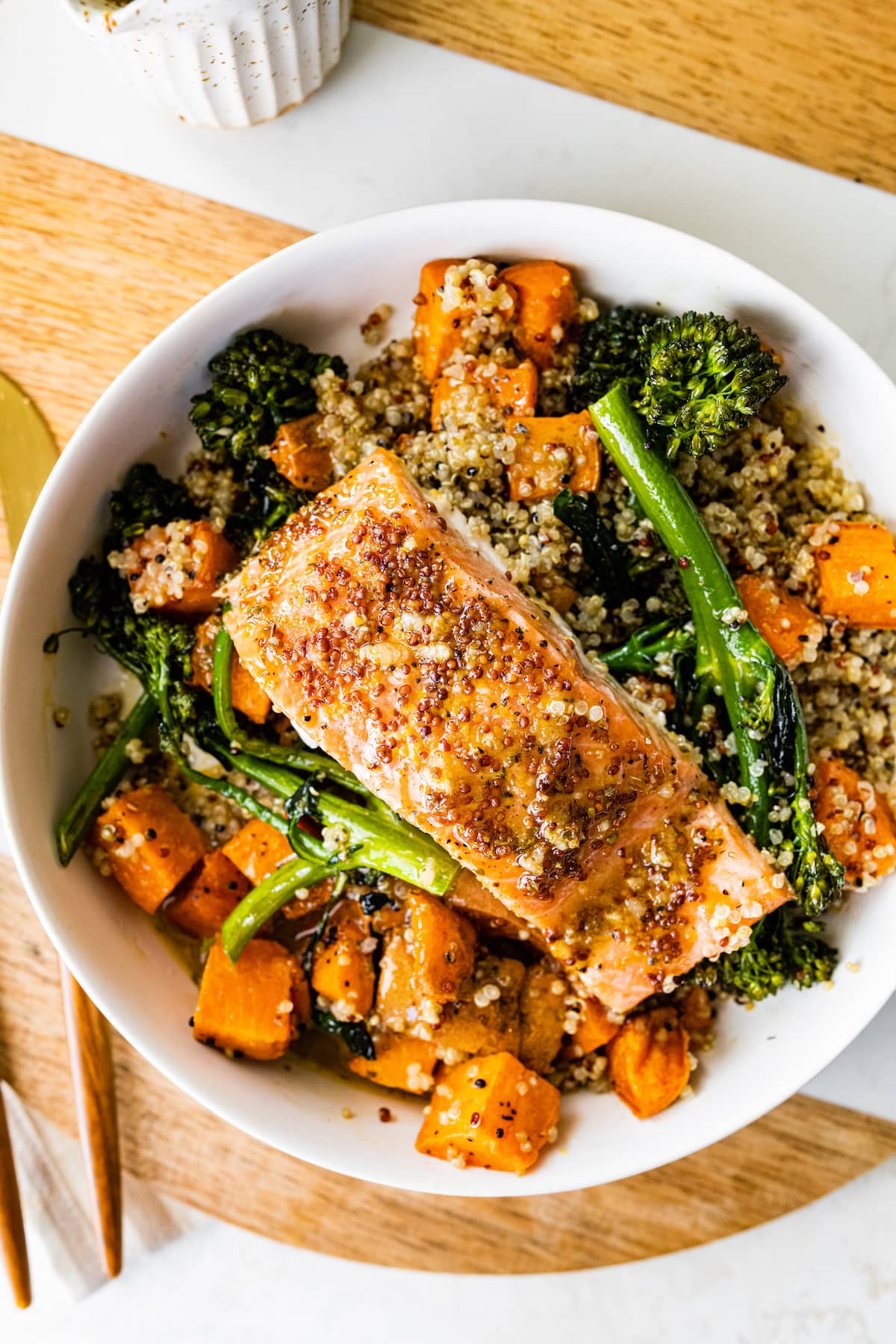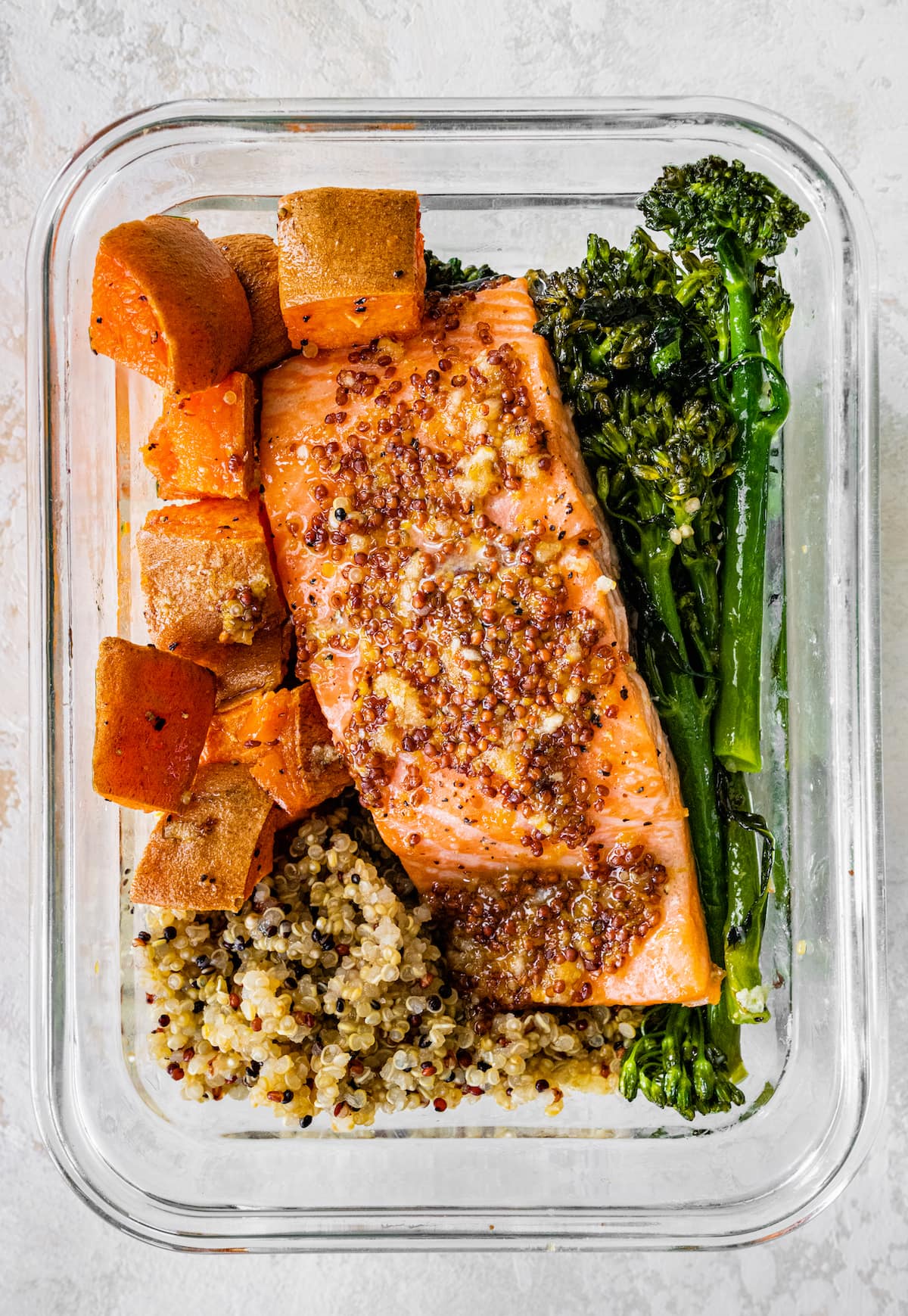Thanks for reading! I’m back with another tasty bowl meal. This one is made for meal prep, so you can make it on Sunday and have lunches ready for the week.
Everyone will love this salmon meal prep bowl as much as I do. It’s so easy to make and tastes great with the roasted vegetables, maple mustard salmon, and lemon vinaigrette.
Salmon is one of the healthiest, tastiest, and most versatile proteins you can add to your weekly meal prep. Rich in heart-healthy omega-3 fatty acids, protein, vitamins, and minerals, salmon offers an array of benefits when enjoyed as part of a balanced diet.
But because salmon has a delicate texture, some home cooks are hesitant to make it ahead of time. People often ask, “Can you meal prep salmon?” or “How do you cook salmon for meal prep?”
The good news is that with proper handling and storage, salmon fillets can be prepped ahead of time for quick and easy meals throughout the busy work week. Read on for a complete guide to safely preparing salmon for your weekly meal prep, including simple recipes and pro tips.
Can You Meal Prep Salmon?
The short answer is yes, you absolutely can meal prep salmon!
In fact, meal prepping is a great way to take advantage of fresh salmon, as you can plan to use up your fillets soon after purchase, rather than holding them for an extra day or two in the fridge.
With the right techniques salmon reheats beautifully retaining moisture and flavor. Follow these tips for success
Choose Quality Salmon Fillets
Seek out fresh, sushi-grade salmon fillets without any “fishy” odor whatsoever. Follow the right steps to handle and keep the salmon cold from the time it was caught.
Wild-caught Alaskan salmon like sockeye and coho are excellent choices. Farmed salmon should display a vibrant pink-orange hue. Any brownish discoloration is a sign of oxidation and spoilage.
Portion Into Individual-Sized Fillets
Buy a big salmon fillet that weighs two to three pounds and cut it into four to six-ounce pieces yourself. This allows more control over fillet thickness. In order for the food to be tender and flaky after cooking and reheating, it should be at least an inch thick.
Season and Pan Sear
A simple preparation like pan-seared salmon works beautifully. Coat both sides of fillets with a bit of olive oil and season generously with salt, pepper, and spice rubs or herbs.
Sear the fillets in a very hot skillet, just until lightly browned on both sides and nearly cooked through but still translucent in the center when cut into.
Undercook Slightly
Since the salmon will be cooked again when you reheat it, undercook it just a bit initially to prevent overcooking later. Salmon can be safely eaten medium or even medium rare.
Cool and Chill Quickly
As soon as the salmon comes off the stove, transfer it to a tray or baking sheet to cool it down rapidly before refrigerating. This helps prevent overcooking and drying out.
Once cooled, pack in meal prep containers and refrigerate. Use within 3-5 days.
Reheat Gently
The safest way to reheat salmon is in the microwave. Take care not to overcook it; salmon can go from succulent to dry and flaky in an instant.
For best results, heat it at 50 percent power in 30 second intervals just until heated through, checking frequently. Ovens and skillets can overcook the fish.
5 Easy Ways to Meal Prep Salmon for the Week
Now that you know proper salmon handling, get ready to enjoy fresh, tender salmon fillets and bowls all week long.
Here are 5 flavorful meal prep salmon recipes that reheat wonderfully:
1. Lemon Herb Salmon Bowls
Bright lemon and fresh herbs give this healthy bowl a summery twist. Serve the seared salmon fillet over quinoa or rice along with roasted veggies.
Flavor combo: Salmon, Lemon, Dill, Parsley
2. Teriyaki Salmon Bowls
For these Asian-inspired bowls, coat salmon fillets with a homemade teriyaki marinade before searing. Serve with stir-fried veggies and rice or noodles.
Flavor combo: Salmon, Soy Sauce, Brown Sugar, Ginger, Garlic
3. Mediterranean Salmon Bowls
Transport your tastebuds to the Mediterranean with salmon seasoned with oregano, fennel and citrus. Add tomatoes, olives, greens and chickpeas.
Flavor combo: Salmon, Lemon, Oregano, Fennel, Garlic
4. BBQ Salmon Bowls
Fire up your meal prepped lunches with salmon fillets coated in a sticky-sweet homemade barbecue sauce before searing. Add corn, beans, coleslaw.
Flavor combo: Salmon, BBQ Sauce, Chili Powder, Garlic
5. Cajun Salmon Bowls
Give your salmon fillets a Cajun kick with spices like smoked paprika, garlic, onion and cayenne before pan-searing and serving over dirty rice with sautéed peppers and onions.
Flavor combo: Salmon, Smoked Paprika, Thyme, Garlic, Onion
Handy Tips for Meal Prepping with Salmon
Follow these handy tips and tricks to get the most out of your meal prepped salmon:
-
Buy fresh: Purchase fresh salmon fillets from a trusted fish market or grocery store seafood counter. Do not use previously frozen salmon.
-
Portion it out: Cut a large fillet into individual 4-6 oz portions for meal prepping. This allows you to sear and cook the fillets correctly.
-
Season generously: Salmon benefits from bold seasonings. Apply rubs and marinades liberally before cooking.
-
Sear thoroughly: Get a nice sear on the fillets for maximum flavor. Use a hot skillet with just a bit of oil.
-
Cook nearly through: Undercook the salmon just slightly since it will cook more when reheated later.
-
Chill ASAP: Cool salmon quickly on a baking sheet before refrigerating to stop carryover cooking.
-
Reheat gently: Use the microwave to reheat salmon fillets. Do so gently in short increments to prevent overcooking.
-
Switch it up: Change up seasonings and bowl ingredients to keep your meal prepped salmon interesting.
-
Use promptly: For food safety, consume refrigerated salmon bowls within 3-5 days. Freeze for longer storage.
How Long Does Salmon Last When Meal Prepped?
When stored properly in the refrigerator, fresh salmon will keep 3-5 days after cooking. Place cooled salmon fillets in airtight containers, keeping air exposure to a minimum.
Use meal prep containers that seal tightly. Glass and BPA-free plastic reheatable containers work great.
Monitor the quality as you reheated the servings later in the week. Discard any salmon with an off odor or color changes.
For longer term storage, meal prepped salmon can be frozen for 2-3 months. Allow fillets to cool completely before freezing in airtight containers or bags. Thaw overnight in the fridge before reheating.
With proper handling, storage, and reheating, salmon can be safely incorporated into your weekly meal prep routine. Follow these tips to enjoy tender, flaky salmon bowls on busy nights. Salmon meal prepping opens up possibilities for amazing flavors and nutrition!

Why You’ll Love This Recipe
- This recipe really goes to the next level with the maple mustard salmon.
- Easy to prepare meals ahead of time so they are ready to go during the week.
- Healthy fats, lean protein, fiber, and many vitamins and minerals make it a complete and balanced meal.
- It’s completely customizable. Feel free to make this recipe your own!.

- quinoa is the main ingredient in the recipe. You can use any kind of quinoa you like, from white to black to red to tri-color. Follow the directions on the package to cook the quinoa, or use this easy guide to cook quinoa.
- vegetable broth—I suggest cooking the quinoa in vegetable broth to make it taste better. You can cook the quinoa in water if you don’t have broth on hand.
- You could also use regular broccoli instead of broccolini. It gives it a nice crunch and is full of health benefits.
- For the sweet potatoes, wash them well and cut them into cubes that are all the same size. I like to leave the skin on the sweet potatoes because that’s where most of the nutrition is, but you can peel them if you’d rather.
- Garlic gives the vegetables and salmon a nice taste.
- avocado oil – for roasting the veggies. If you have olive oil on hand, you could also use that.
- Salt from the sea
- Salmon is the star of this dish and a great source of omega-3 fatty acids and protein. You’ll need 4 filets of salmon that are all about the same size and have the skin on them. You should get individual filets from your grocery store, but don’t be afraid of frozen filets either. Fish that has been flash-frozen can be just as healthy. If you use frozen filets of salmon, make sure it’s no longer frozen first.
- A tasty and sweet sauce made from whole grain mustard, lemon juice, maple syrup, garlic, salt, and pepper is called maple mustard sauce. Dijon mustard will work instead of whole-grain mustard if you don’t have it. Honey can be used instead of maple syrup.
- lemon vinaigrette—this tasty lemon vinaigrette really makes the bowl shine!

Cook quinoa: Rinse and drain quinoa. Add quinoa and broth (or water) to a saucepan and bring to a boil. Reduce to a simmer, cover and cook for 15 minutes. Fluff with a fork and let cool for 5-10 minutes.
To roast sweet potatoes, put the chunks of sweet potato in a large bowl and mix them with 1 tablespoon of oil, ½ teaspoon of salt, and ¼ teaspoon of pepper. Put the sweet potato chunks on a sheet pan that has been lined with foil or parchment paper. Roast at 400°F for 20 minutes, flipping the potatoes over halfway through. Save the bowl for later use.
Add broccolini to the same bowl you used for the sweet potatoes and toss it with 1 tablespoon of oil, garlic, ½ teaspoon of salt, and ¼ teaspoon of pepper. Season with salt and pepper to taste. After 20 minutes, add broccolini to one half of the baking sheet with the sweet potatoes. Put the whole thing back in the oven and roast for another 12 to 15 minutes, until both the broccolini and the sweet potatoes are soft.
Cook salmon: Season both sides of each salmon filet with salt and pepper. Place filets skin-side down on a parchment-lined baking dish or tray and roast for 10 minutes at 400°F. While roasting, mix together mustard, lemon juice, maple and garlic. Now take the salmon out of the oven and cover it with sauce. Put it back in the oven for another 4 to 5 minutes, or until it is fully cooked and flaky.
Serve: Divide quinoa into 4 servings (about ½ cup). Top with veggies, salmon and a drizzle of lemon vinaigrette. Enjoy!.

These salmon bowls are totally customizable! Here are some ideas on how to make this recipe your own:

How to Meal Prep
This is the ultimate meal prep bowl. You can prep all of the components in advance and have a delicious, filling meal in minutes!.
How to store: In four glass storage containers add a layer of quinoa to the bottom, followed by one salmon filet. Then add 1/4 of the sweet potatoes and broccolini next to the salmon, cover and store in the fridge for up to 4 days. Store the dressing in a separate container.
When you’re ready to eat, heat it up in the oven, microwave, or toaster oven. Then, drizzle some dressing on top and serve!
Meal Prep Honey Garlic Salmon Bowls | Episode 7
FAQ
How long can salmon meal prep last?
Can you meal prep fish for 5 days?
Can I meal prep raw salmon?
How long can cooked salmon stay in the fridge?
How to cook salmon for meal prep?
First, you need to decide on the best way to cook salmon for meal prep. Because salmon can come in all shapes and sizes, I like to buy my own large, skinned fillet and then divide it into 4-6 oz. portions. That way, I know the exact size of the salmon portions AND I save money of having the grocery store pre-slice it.
Is fresh salmon safe to eat?
Yes, salmon is a source of omega 3, the fatty acid is responsible for acting in the prevention of cardiovascular diseases, making the heart strong and healthy. Just be careful to analyze the supplier to make sure it doesn’t have any contamination.
Is salmon good for meal prep?
Spice up your meal prep with these salmon meal prep recipes. Salmon is an excellent source of protein. Protein helps keep you full, so you’re not reaching for unhealthy snacks later on. Salmon is also packed with brain-boosting omega-3s. Make sure you have some meal prep containers to store all that tasty food.
Do you have to cook salmon all the way?
You don’t have to cook salmon all the way. Since salmon isn’t like chicken and can be eaten slightly undercooked anyways, you can almost cook the salmon all the way through. That way, when you’re reheating the salmon later, it will not be overcooked, dry and crumbly.
